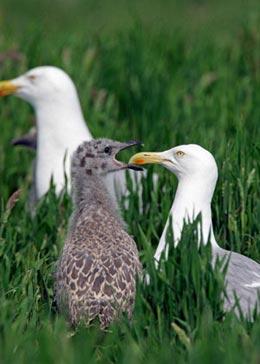
One of the features of the herring gull, Larus argentatus, is that it has a red spot below its beak. This spot is crucial for the parents when feeding the gull chicks. Infants will peck on the red spot of their parents, indicating hunger to them. In turn, parents will gorge out food to feed their child. This behaviour has been found even in chicks that were just born, supporting the existence of innate behaviour (ten Cate, 2009; Tinbergen, 1953).
According to Baerends (1988), the red spot is a sign stimulus that is required to elicit such a pecking response from the chicks. This sign stimulus can be exaggerated to elicit a more vigorous response. As the video showed, by adding an additional 2 more stripes to the yellow stick, the chicks pecked more than usual and also at a faster rate. This exaggerated sign stimulus is called a supernormal stimulus.
References
Baerends, G. P. (1988). Ethology. In R. C. Atkinson, R. J. Herrnstein, G. Lindzey, & R. D. Luce (Eds.), Stevens’ handbook of experimental psychology (Vol. 1, pp. 765 – 830). New York: Wiley.
ten Cate, C. (2009). Niko Tinbergen and the red patch on the herring gull’s beak. Animal behaviour, 77(4): 785 – 794.
Tinbergen, N. (1953). The herring gull’s world: A study of the social behaviour of birds. London: Collins.
“Herring gulls,” by Imagebroker. Nature, 24 March 2009. URL: http://www.nature.com/news/2009/090324/images/herring-gull.jpg (accessed on 8 April 2010)
“More human than human – herring gull chicks,” by Esthetica1. Youtube, 21 September 2009. URL: http://www.youtube.com/watch?v=Y5azoIGlz3U (accessed on 8 April 8, 2010).
